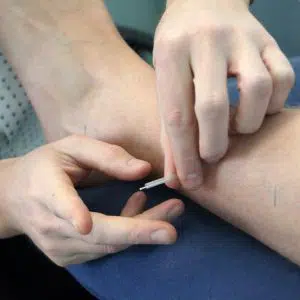Dry Needling / Trigger Point Therapy in Perth
How does trigger point release / dry needling work?
What is dry needling?
Dry needling is a very safe and effective way to remove muscle knots which in turn cause pain and dysfunction. This technique had a very positive effect on relaxing muscles. (see examples below)
Compression techniques (massage) instead of dry needling can also be used for those that don’t like needles. When compression is applied to the trigger point, it acts to ‘jump start’ the muscle and its nerve supply. This usually results in a reflex relaxation of the muscle.


Dry needling examples: into foot and lower leg using sterile acupuncture needles.
What is a Trigger Point?
A trigger point is a hypersensitive region within a muscle (like those tender ‘knots’ or lumps that you can feel when you are stressed!). When compression is applied or a needle is inserted into the trigger point, it acts to ‘jump start’ the muscle and its nerve supply. This usually results in a reflex relaxation of the muscle.
When do I feel better?
For the rest of the day, your muscles can feel achy and tired, a bit like they have done a big workout at the gym. It is a good idea to drink plenty of water, and rest if tired. Some people feel better straight away while others feel better a day or two later.
“But I’m scared of needles!”
Most people who have it done will see and feel the benefit and tend to be fine and want to come back for more. There is virtually a pain-free superficial dry needling technique that works well at isolating the more severe trigger points that they can be massaged. Should you really not like dry needling there are other ways that we can help with your condition such as trigger point release using the conventional compression technique, fascial release techniques, and stretch and spray techniques using the cold spray. We will use the most effective treatment technique that you are comfortable with to get you back on your feet.
For More Please visit Foot Focus Podiatry to discuss your needs with Brent and his team.

